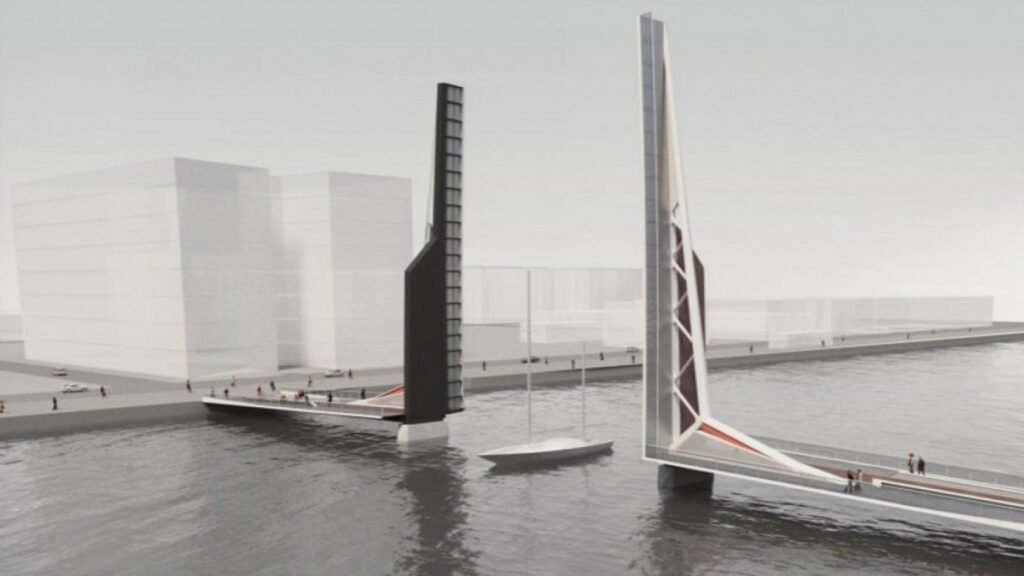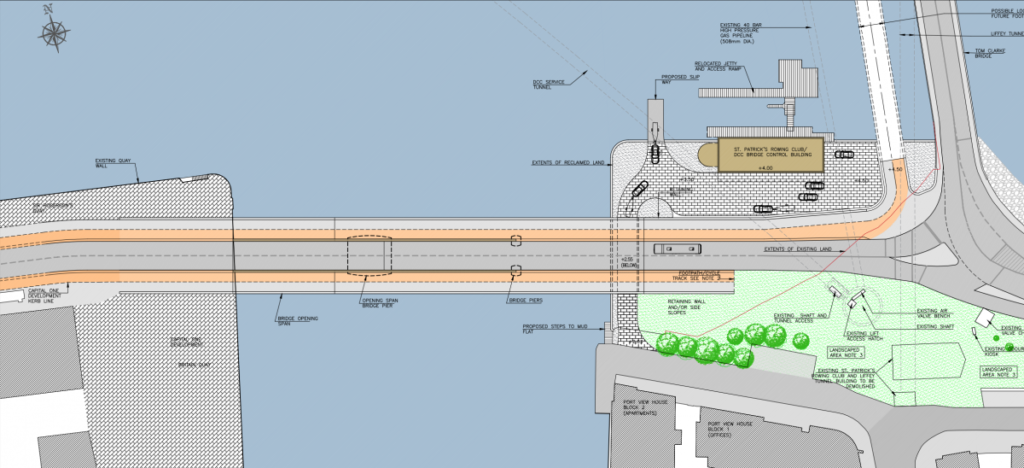Docklands bridges to improve connectivity within Dublin. Blood Stoney Bridge said to cost €20 million
Several bridges are being currently projected in the Docklands Area.

Two small bridges for pedestrians and cyclists were officially opened in the Docklands Area of Dublin on December 20.
Several bridges are being currently projected in the Docklands Area, a modern business hub near the Dublin city centre, to improve connectivity within the area.
This includes a new pedestrian and cyclist twin bridge over the Royal Canal on the North Wall Quay, near Samuel Beckett Bridge. It was officially opened a few days before Christmas.

Three other bridges are to be constructed in the area around River Liffey: Blood Stoney Bridge and Point Bridge for cyclists and pedestrians and Dodder Bridge for public transport.
Nonetheless, it is the Blood Stoney Bridge, which will be built near the Central Bank of Ireland, that has drawn attention of the media after it was discussed by committees within the Dublin City Council (DCC).
Blood Stoney Bridge location to be approved first
The intention to build new bridges over River Liffey in the Docklands area first appeared in 2014 when the North Lotts and Grand Canal Strategic Development Zone Planning Scheme was approved.
Blood Stoney Bridge, the first dedicated cycling and pedestrian bridge running over the river, will stand mid-way between the existing Samuel Beckett Bridge to the west and the East Link Bridge, known also as Tom Clarke Bridge, to the east.
The new bridge was initially supposed to link Forbes Street to Park Lane. However, the approved scheme did not consider the fact that the bridge would interfere with the proposed Dublin Area Rapid Transit (DART) Underground.
“A bridge at the Forbes Street location would have an unacceptable detrimental effect on the DART Underground project. This has led the DCC and the National Transport Authority (NTA) to reject Forbes Street as a viable location for the bridge,” the report on Blood Stoney Bridge reads.
Hence, the bridge location has been moved about 200 metres further east, connecting the riverbanks at the Blood Stoney Road and New Wapping Street. An Bord Pleanála declined to accept this amendment in early January of 2019.

“We decided to put in a new updated application to An Bord Pleanála again for the Blood Stoney location, which is further back up,” said Marie Gavin, DCC’s senior resident engineer, on December 4.
The application was submitted to the Board this August, and the DCC is hoping to get the decision in this matter soon.
“That would mean, then, we can launch a planning application for the bridge at the Blood Stoney location,” Ms Gavin added.
Blood Stoney Bridge to cost €20 million
The area where the new bridge will stand is expected to experience a substantial increase of new workers, as high as 22,000 in the coming years, with minimum car parking being provided. The city, hence, wants to focus on and invest in a more sustainable means of transport, also because the demand in biking spaces is growing. The funding for this bridge will be covered by levies from the DCC and support provided by the NTA.
“We currently have a cost estimate developed up, and we’re just over the threshold for the €20 million at the moment,” Ms Gavin told the Central Area Committee on December 10.

The DCC has also asked a consultant to do an independent review of the City Council’s own estimate when it comes to the costs of Blood Stoney Bridge. When it is completed, the DCC will communicate the price to the public and seek approval from the department of public expenditure.
Councillor Janet Horner, who has welcomed an idea of the new cycling bridge, has doubts whether the wider Dublin community would benefit from the new piece of infrastructure. She underlined people riding a bike alongside the Liffey are risking their lives for the lack of cycling infrastructure.
Will Blood Stoney get a new name?
Another councillor, Nial Ring, objected to the name of the bridge, which is now named after the nearby street. Bindon Blood Stoney was an Irish engineer who designed O’Connell Bridge, Butt Bridge and Grattan Bridge in Dublin.

“The name has not been officially tied down yet, and there will be a public consultation process on that,” Ms Gavin told the Committee. She added there are, nevertheless, guidelines to be followed; it is likely a bridge will be named after another engineer or architect who contributed to the Docklands area.
Works on the bridge design as well as a report on environmental impacts are being progressed although the planning application will be put forward only in early 2020. Also, it is expected the 125-long low-level bridge with a twin bascule will be completed no sooner than in 2023.
“It is anticipated that construction will start in mid-2021 and will take approximately 18 months to complete,” the report reads.
A newly-opened twin bridge as a Christmas gift
While the construction of Blood Stoney Bridge has not even started, the Docklands area witnessed smaller pedestrian and cyclist bridges over the Royal Canal, near the Convention Centre Dublin, opened on December 20.
‘If we want to encourage people to use alternative forms of transport and to leave the car at home, we must provide the appropriate infrastructure and motivate them to do that,” MP Paschal Donohoe said during the opening ceremony, as quoted in the press release.
The National Transport Authority funded the construction. The twin bridge has now become an integral part of the long-term Liffey Cycle Way project.
Other bridges in the Docklands Area of Dublin
As regards the Dodder Public Transport Bridge, the project is at its preliminary design stage, and the environmental impact assessment is almost complete. A planning application should be submitted in 2020, the DCC’s Gavin said. The completion of this Dublin bridge is estimated for late 2022.

The bridge is to connect Sir John Rogerson’s Quay and the area between York Road and Thorncastle Street on the Poolbeg Peninsula, near the Tom Clarke Bridge. The construction will be capable of opening so that the river traffic can pass up and down the stream. Private cars will be prohibited, but the bridge could accommodate the LUAS in future. The costs are estimated at €31.5 million, as reported by the website irishcycle.com in 2017.
The Point Pedestrian and Cycling Bridge will be constructed immediately to the west of the Tom Clarke Bridge. Consultations are ongoing to figure out how the new bridge can be incorporated into the workings of the Tom Clarke Bridge.
